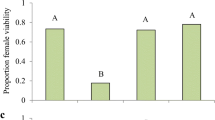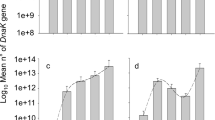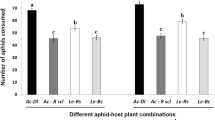Abstract
The interactions among host plants(Medicago sativa L., cv. `OKO8' and Vicia faba L., cv. `Windsor'), aphid prey(Acyrthosiphon pisum Harris, Homoptera:Aphididae), and Coccinella septempunctata L. (Coleoptera: Coccinellidae) preimaginal biology were evaluated. Interactions were measured over a range of limiting daily prey levels (1.2 mg–16.4 mg)from each host plant colony. Compared withA. pisum reared on V. faba, A. pisum reared on M. sativa storedsignificantly more fatty acids which resultedin a 1.17-fold increase in available caloriesfor developing C. septempunctata. Theincreased survival, decreased developmentaltimes, and larger size of C.septempunctata supplied with A. pisumreared on M. sativa clearly demonstratehost plant effects at the third trophic level. At low very limiting daily prey levels, A. pisum reared on M. sativa were moresuitable prey for C. septempunctatasurvival, development, and adult size thanA. pisum reared on V. faba. Coccinella septempunctata survival ratios(larval), developmental times, and adult sizeconverged (were not statistically different)between host plants at higher daily A.pisum levels. These convergence's supportthe hypothesis that there were quantitativedifferences in the nutritional value ofaphids, as influenced by differences in fattyacids and subsequent nutritional levels(calories), between aphids reared on separateplant hosts. The observed tritrophicinteractions appear to be modulated by thebiochemical response of A. pisum to hostplants.
Similar content being viewed by others
References
A.O.A.C., 1990. Official Methods of Analysis, 15th ed. Association of Official Analytical Chemists. Arlington, VA.
Bashir, M.O., 1973. Effect of Nutrition on Development and Reproduction of Aphidophagous Coccinellids with Special Reference to Olla Abdominalis (Say). PhD Dissertation. University of California, Berkeley. 171 pp.
Baumgaertner, J.U., A.P. Gutierrez and C.G. Summers, 1981. The influence of aphid prey consumption on searching behavior, weight increase, developmental time, and mortality of Chrysopa carnea (Neuroptera: Chrysopidae) and Hippodamia convergens (Coleoptera: Coccinellidae) larvae. Can. Entomol. 113: 1007–1014.
Bergman, D.K., R.M. Edwards, R.C. Berberet and J.W. Dillwith, 1990. Fatty acid composition of pea aphids on two hosts. In: Proc. Aphid-Plant Interactions: Populations to Molecules. Stillwater, OK. MP-132. p. 295.
Bergman, D.K., J.W. Dillwith and R.C. Berberet, 1991. Spotted alfalfa aphid, Therioaphis maculata, fatty acids relative to the condition and susceptibility of its host. Arch. Insect Biochem. Physiol. 18: 1–12.
Bottrell, D.G., P. Barbosa and F. Gould, 1998. Manipulating natural enemies by plant variety selection and modification: a realistic strategy. Annu. Rev. Entomol. 43: 347–367.
Campbell, R.K., D.K. Reed, J.D. Burd and R.D. Eikenbary, 1992. Russian wheat aphid and drought stresses in wheat: tritrophic interactions with Diaeretiella rapae and plant resistance. In: S.B.J. Menken, J.H. Visser and P. Harrewijn (eds.), Proc. 8th Int. Symp. Insect-Plant Relationships. Kluwer Academic Publishers, Dordrecht pp. 297–298.
Dillwith, J.W., P.A. Neese and D.L. Brigham, 1993. Lipid biochemistry in aphids. In: D.W. Stanley-Samuelson and D.R. Nelson (eds.), Insect Lipids: Chemistry, Biochemistry, and Biology. University of Nebraska Press, Lincoln and London. pp. 389–434.
Giles, K.L., R.D. Madden, M.E. Payton and J.W. Dillwith, 2000. Survival and development of Chrysoperla rufilabris (Neuroptera: Chrysopidae) supplied with pea aphids (Homoptera: Aphididae) reared on alfalfa and faba bean. Environ. Entomol. 29: 304–311.
Hodek, I., 1993. Habitat and food specificity in aphidophagous predators. Biocontrol Science and Tech. 3: 91–100.
Hodek, I. and A. Hon?ek, 1996. Ecology of Coccinellidae. Kluwer Academic Publishers, Dordrecht.
Jervis, M. and N. Kidd, 1996. Insect Natural Enemies: Practical Approaches to Their Study and Evaluation. Chapman and Hall, London.
Kareiva, P. and R. Sahakian, 1990. Tritrophic effects of a simple architectural mutation in pea plants. Nature. 345: 433–434.
Mills, N.J., 1981. Some aspects of the rate of increase of a coccinellid. Ecol. Entomol. 6: 293–299.
Neese, P.A., 1995. Fatty acid Metabolism in the Pea Aphid, Acyrthosiphon Pisum (Harris): Regulation in Relation to Plant Host. PhD Dissertation. Oklahoma State University, Stillwater, OK.
Obrycki, J.J. and C.A. Orr, 1990. Suitability of three prey species for nearctic populations of Coccinella septempunctata, Hippodamia variegata, and Propylea quatuordecimpunctata (Coleoptera: Coccinellidae). J. Econ. Entomol. 83: 1292–1297.
Obrycki, J.J., A.M. Ormord and K.L. Giles, 1997. Partial life table analysis for larval Coleomegilla maculata (Degeer) and Coccinella septempunctata L. (Coleoptera: Coccinellidae). J. Kansas. Entomol. Soc. 70: 339–346.
Obrycki, J.J., K.L. Giles and A.M. Ormord, 1998. Interactions between an introduced and indigenous coccinellid species at different prey densities. Oecologia 117: 279–285.
Obrycki, J.J. and T.J. Kring, 1998. Predaceous coccinellidae in biological control. Annu. Rev. Entomol. 43: 295–321.
Phoofolo, M.W. and J.J. Obrycki, 1995. Comparative life-history studies of nearctic and palearctic populations of Coccinella septempunctata (Coleoptera: Coccinellidae). Environ. Entomol. 24: 581–587.
Power, M., 1992. Top-down and bottom-up forces in food webs: do plants have primacy? Ecology 73: 733–746.
Price, P.W., 1997. Insect Ecology. John Wiley & Sons, New York.
Rice, M.E. and G.E. Wilde, 1989. Antibiosis effect of sorghum on the convergent lady beetle (Coleoptera: Coccinellidae), a third-trophic level predator of the greenbug. J. Econ. Entomol. 82: 570–573.
SAS Institute, 1996. Version 6.12. SAS Institute, Cary, NC.
Souissi, R. and B. Le Ru, 1997. Effect of host plants on fecundity and development of Apoanagyrus lopezi, and endoparasitoid of the cassava mealybug, Phenacoccus maihoti. Entomol. Exp. Appl. 82: 235–238.
Starks, K.J., R. Muniappan and R.D. Eikenbary, 1972. Interaction between plant resistance and parasitism against the greenbug on barley and sorghum. Ann. Entomol. Soc. Am. 65: 650–655.
Sundby, R.A., 1968. Some factors influencing the reproduction and longevity of Coccinella septempunctata Linnaeus [(Coleoptera: Coccinellidae)]. Entomophaga 13: 197–202.
Thompson, S.N., 1999. Nutrition and culture of entomophagous insects. Annu. Rev. Entomol. 44: 561–592.
Thompson, S.N. and K.S. Hagen, 1999. Nutrition of entomophagous insects and other arthropods. In: T.S. Bellows and T.W. Fisher (eds.), Handbook of Biological Control: Principles and Applications of Biological Control. Academic Press, San Diego.
van Emden and S.D. Wratten, 1990. Tritrophic interactions involving plants in the biological control of aphids. In: Proc. Aphid-plant Interactions: Populations to Molecules. Stillwater, OK. MP-132. pp. 29–44.
Weiser, L.A. and N.E. Stamp, 1998. Combined effects of allelochemicals, prey availability, and supplemental plant material on growth of a generalist insect predator. Entomol. Exper. Appl. 87: 181–189.
Author information
Authors and Affiliations
Rights and permissions
About this article
Cite this article
Giles, K., Madden, R., Stockland, R. et al. Host plants affect predator fitness via the nutritional value of herbivore prey: Investigation of a plant-aphid-ladybeetle system. BioControl 47, 1–21 (2002). https://doi.org/10.1023/A:1014419623501
Issue Date:
DOI: https://doi.org/10.1023/A:1014419623501




